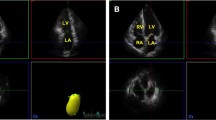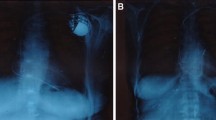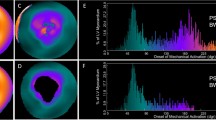Abstract
Background
The aim of this study was to demonstrate that only mechanical dyssynchrony outside the area of segmental wall motion abnormalities (WMA) can be reduced by cardiac resynchronization therapy (CRT).
Methods and results
Included in the study were 28 consecutive patients with nonischaemic cardiomyopathy selected for CRT. Equilibrium radionuclide angiography (ERNA) was carried out before and after implantation of a multisite pacemaker. Patients were separated into two groups depending on the presence or absence of segmental WMA.
Results
A reduction in QRS duration was observed in all patients after CRT. The interventricular delay (IVD) decreased significantly after CRT only in patients without WMA (homogeneous contraction, HG group; IVD 44 ± 11.4° vs. 17 ± 3.1°, p = 0.04). In contrast, no significant decrease was observed in patients with WMA (WMA group; IVD 51 ± 6° vs. 38 ± 6°, p NS). However, when dyssynchrony was considered outside the WMA area, a significant reduction in IVD was obtained, in the same range as in the HG group (IVD 32 ± 3° vs. 19 ± 3°, p = 0.04). In 9 of 15 patients (60%) with a reduction in IVD after CRT, the left ventricle ejection fraction (LVEF) increased by about +10%. In contrast, in 13 of 13 patients (100%) with no reduction in IVD, no modification of LVEF was obtained. In the presence of segmental WMA without significant delays outside the WMA area, no reduction in IVD was observed and LVEF did not increase (IVD 34 ± 5° before CRT vs. 37 ± 7° after CRT; LVEF 19 ± 4% before CRT vs. 22 ± 3% after CRT, p NS).
Conclusion
ERNA can be used to predict good mechanical resychronization (decrease in IVD) in patients after pacing. IVD has to be determined excluding the area of WMA in order to select patients who will show an increase in their left ventricle function after CRT.






Similar content being viewed by others
References
Ansalone G, Giannantoni P, Ricci R, et al. Biventricular pacing in heart failure: back to basics in the pathophysiology of left bundle branch block to reduce the number of nonresponders. Am J Cardiol 2003;91:55F–61F.
Auricchio A, Spinelli JC, Trautmann SI, Kloss M. Effect of cardiac resynchronization therapy on ventricular remodeling. J Card Fail 2002;8:S549–55.
Cazeau S, Gras D, Lazarus A, Ritter P, Mugica J. Multisite stimulation for correction of cardiac asynchrony. Heart 2000;84:579–81.
Bader H, Garrigue S, Lafitte S, et al. Intra-left ventricular electromechanical asynchrony. A new independent predictor of severe cardiac events in heart failure patients. J Am Coll Cardiol 2004;43:248–56.
Breithardt OA, Stellbrink C, Herbots L, et al. Cardiac resynchronization therapy can reverse abnormal myocardial strain distribution in patients with heart failure and left bundle branch block. J Am Coll Cardiol 2003;42:486–94.
Bax JJ, Ansalone G, Breithardt OA, et al. Echocardiographic evaluation of cardiac resynchronization therapy: ready for routine clinical use? A critical appraisal. J Am Coll Cardiol 2004;44:1–9.
Bleeker GB, Mollema SA, Holman ER, et al. Left ventricular resynchronization is mandatory for response to cardiac resynchronization therapy: analysis in patients with echocardiographic evidence of left ventricular dyssynchrony at baseline. Circulation 2007;116:1440–8.
Van de Veire NR, Bleeker GB, De Sutter J, et al. Tissue synchronisation imaging accurately measures left ventricular dyssynchrony and predicts response to cardiac resynchronisation therapy. Heart 2007;93:1034–9.
Yu CM, Zhang Q, Fung JW, et al. A novel tool to assess systolic asynchrony and identify responders of cardiac resynchronization therapy by tissue synchronization imaging. J Am Coll Cardiol 2005;45:677–84.
Casset-Senon D, Philippe L, Babuty D, et al. Diagnosis of arrhythmogenic right ventricular cardiomyopathy by Fourier analysis of gated blood pool single-photon emission tomography. Am J Cardiol 1998;82:1399–404.
Eder V, Bernis F, Drumm M, et al. Three-dimensional analysis of left ventricle regional wall motion by using gated blood pool tomography. Nucl Med Commun 2004;25:971–8.
Fauchier L, Marie O, Casset-Senon D, et al. Interventricular and intraventricular dyssynchrony in idiopathic dilated cardiomyopathy: a prognostic study with Fourier phase analysis of radionuclide angioscintigraphy. J Am Coll Cardiol 2002;40:2022–30.
Fauchier L, Marie O, Casset-Senon D, et al. Ventricular dyssynchrony and risk markers of ventricular arrhythmias in nonischemic dilated cardiomyopathy: a study with phase analysis of angioscintigraphy. Pacing Clin Electrophysiol 2003;26:352–6.
Boogers MM, Van Kriekinge SD, Henneman MM, et al. Quantitative gated SPECT-derived phase analysis on gated myocardial perfusion SPECT detects left ventricular dyssynchrony and predicts response to cardiac resynchronization therapy. J Nucl Med 2009;50:718–25.
Fauchier L, Eder V, Casset-Senon D, et al. Segmental wall motion abnormalities in idiopathic dilated cardiomyopathy and their effect on prognosis. Am J Cardiol 2004;93:1504–9.
Buch E, Lellouche N, De Diego C, et al. Left ventricular apical wall motion abnormality is associated with lack of response to cardiac resynchronization therapy in patients with ischemic cardiomyopathy. Heart Rhythm 2007;4:1300–5.
Eder V, Fauchier L, Courtehoux M, Bonnet P, Babuty D. Segmental wall motion abnormality analyzed by equilibrium radionuclide angiography and improvement in ventricular function by cardiac resynchronization therapy. Pacing Clin Electrophysiol 2007;30 Suppl 1:S58–61.
Kerwin WF, Botvinick EH, O'Connell JW, et al. Ventricular contraction abnormalities in dilated cardiomyopathy: effect of biventricular pacing to correct interventricular dyssynchrony. J Am Coll Cardiol 2000;35:1221–7.
Le Rest C, Couturier O, Turzo A, et al. Use of left ventricular pacing in heart failure: evaluation by gated blood pool imaging. J Nucl Cardiol 1999;6:651–6.
Rivero-Ayerza M, Theuns DA, Garcia-Garcia HM, et al. Effects of cardiac resynchronization therapy on overall mortality and mode of death: a meta-analysis of randomized controlled trials. Eur Heart J 2006;27:2682–8.
Muxi A, Paredes P, Mont L, et al. Left ventricular function and visual phase analysis with equilibrium radionuclide angiography in patients with biventricular device. Eur J Nucl Med Mol Imaging 2008;35:912–21.
del Romeral LM, Stillson C, Lesh M, Botvinick E. The variable functional effects of the pacing site in normal and scarred ventricles. J Nucl Cardiol 2009;16:904–13.
Ypenburg C, van Bommel RJ, Delgado V, et al. Optimal left ventricular lead position predicts reverse remodeling and survival after cardiac resynchronization therapy. J Am Coll Cardiol 2008;52:1402–9.
Conflicts of interest
None.
Author information
Authors and Affiliations
Corresponding author
Rights and permissions
About this article
Cite this article
Courtehoux, M., Zannad, N., Fauchier, L. et al. Interventricular delay measurement using equilibrium radionuclide angiography before resynchronization therapy should be performed outside the area of segmental wall motion abnormalities. Eur J Nucl Med Mol Imaging 38, 239–244 (2011). https://doi.org/10.1007/s00259-010-1629-4
Received:
Accepted:
Published:
Issue Date:
DOI: https://doi.org/10.1007/s00259-010-1629-4




